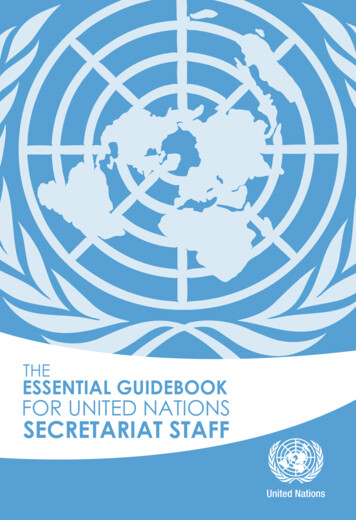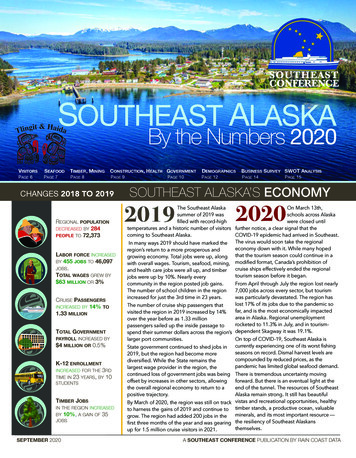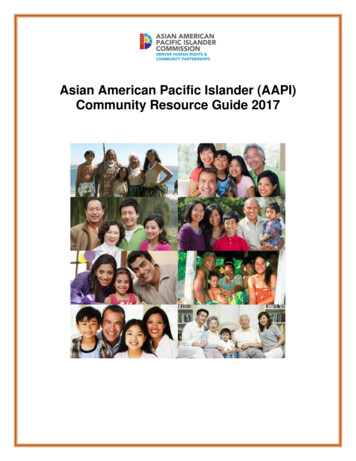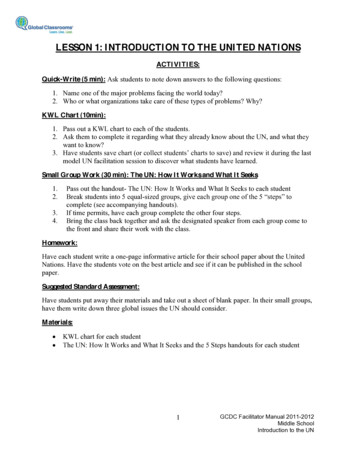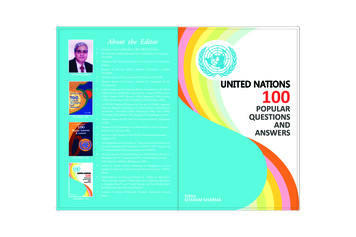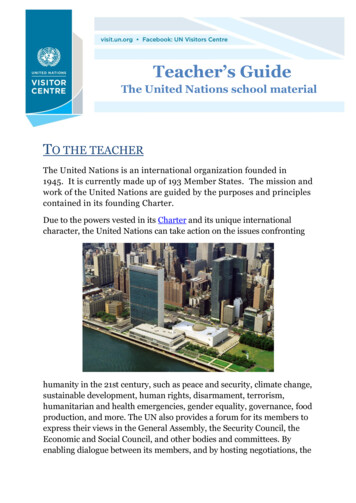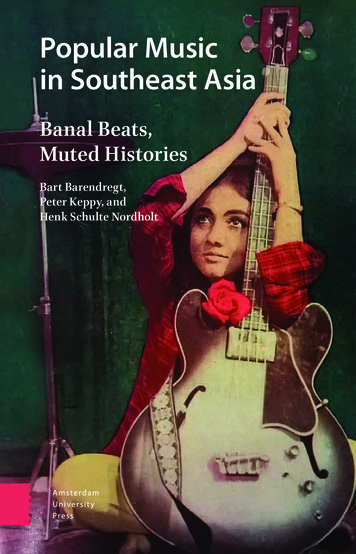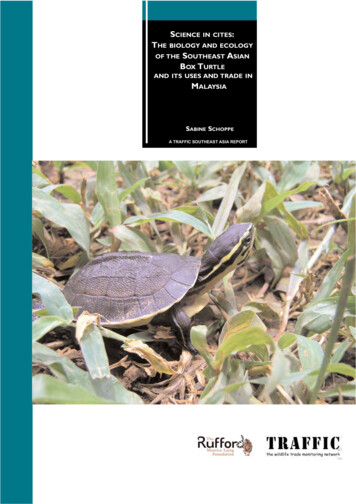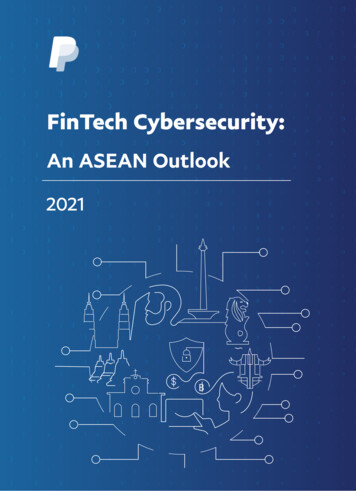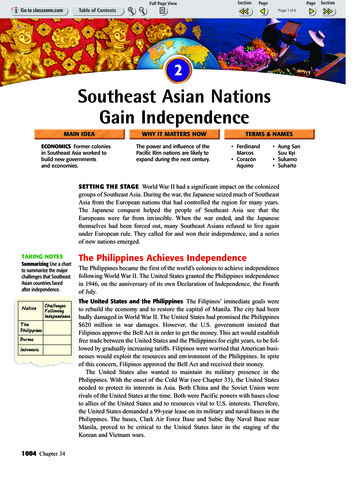
Transcription
Page 1 of 62Southeast Asian NationsGain IndependenceMAIN IDEAECONOMICS Former coloniesin Southeast Asia worked tobuild new governmentsand economies.WHY IT MATTERS NOWThe power and influence of thePacific Rim nations are likely toexpand during the next century.TERMS & NAMES FerdinandMarcos CorazónAquino Aung SanSuu Kyi Sukarno SuhartoSETTING THE STAGE World War II had a significant impact on the colonizedgroups of Southeast Asia. During the war, the Japanese seized much of SoutheastAsia from the European nations that had controlled the region for many years.The Japanese conquest helped the people of Southeast Asia see that theEuropeans were far from invincible. When the war ended, and the Japanesethemselves had been forced out, many Southeast Asians refused to live againunder European rule. They called for and won their independence, and a seriesof new nations emerged.TAKING NOTESSummarizing Use a chartto summarize the majorchallenges that SoutheastAsian countries facedafter ThePhilipippinesBurmaIndonesia1004 Chapter 34The Philippines Achieves IndependenceThe Philippines became the first of the world’s colonies to achieve independencefollowing World War II. The United States granted the Philippines independencein 1946, on the anniversary of its own Declaration of Independence, the Fourthof July.The United States and the Philippines The Filipinos’ immediate goals wereto rebuild the economy and to restore the capital of Manila. The city had beenbadly damaged in World War II. The United States had promised the Philippines 620 million in war damages. However, the U.S. government insisted thatFilipinos approve the Bell Act in order to get the money. This act would establishfree trade between the United States and the Philippines for eight years, to be followed by gradually increasing tariffs. Filipinos were worried that American businesses would exploit the resources and environment of the Philippines. In spiteof this concern, Filipinos approved the Bell Act and received their money.The United States also wanted to maintain its military presence in thePhilippines. With the onset of the Cold War (see Chapter 33), the United Statesneeded to protect its interests in Asia. Both China and the Soviet Union wererivals of the United States at the time. Both were Pacific powers with bases closeto allies of the United States and to resources vital to U.S. interests. Therefore,the United States demanded a 99-year lease on its military and naval bases in thePhilippines. The bases, Clark Air Force Base and Subic Bay Naval Base nearManila, proved to be critical to the United States later in the staging of theKorean and Vietnam wars.
Page 2 of 6Southeast Asia, kokPHILIPPINES1946ManilaSOUTH1,000 Miles0CAMBODIA1954 VIETNAM1954PhnomPenhINDIANOCEAN120 EINDIA160 EFormer British colonyFormer Dutch colonyFormer French colonyFormer U.S. colonyContinuously independent1945 Date of independenceCHINA02,000 KilometersSaigonPAC I F I COCEANMALAYSIA1957BRUNEI(Br.)Kuala LumpurSingapore0 EquatorBORNEO1965INDONE1949SIAJakartaEAST TIMOR(Port.)GEOGRAPHY SKILLBUILDER: Interpreting Maps1. Location Which former Dutch colony is made up of a series of islands spread out from theIndian Ocean to the Pacific Ocean?2. Region From what European country did the most colonies shown above gain theirindependence?MakingInferencesWhy might theUnited States havebeen interested inmaintaining militarybases in thePhilippines?These military bases also became the single greatest source of conflict betweenthe United States and the Philippines. Many Filipinos regarded the bases as proofof American imperialism. Later agreements shortened the terms of the lease, andthe United States gave up both bases in 1992.After World War II, the Philippine government was still almost completelydependent on the United States economically and politically. The Philippine government looked for ways to lessen this dependency. It welcomed Japanese investments. It also broadened its contacts with Southeast Asian neighbors and withnonaligned nations.From Marcos to Ramos Ferdinand Marcos was elected president of thePhilippines in 1965. The country suffered under his rule from 1966 to 1986.Marcos imposed an authoritarian regime and stole millions of dollars from the public treasury. Although the constitution limited Marcos to eight years in office, hegot around this restriction by imposing martial law from 1972 to 1981. Two yearslater, his chief opponent, Benigno Aquino, Jr., was assassinated as he returned fromthe United States to the Philippines, lured by the promise of coming elections.In the elections of 1986, Aquino’s widow, Corazón Aquino, challengedMarcos. Aquino won decisively, but Marcos refused to acknowledge her victory.When he declared himself the official winner, a public outcry resulted. He wasforced into exile in Hawaii, where he later died. In 1995, the Philippines succeeded in recovering 475 million Marcos had stolen from his country anddeposited in Swiss banks.The Colonies Become New Nations 1005
Page 3 of 6As she took the oath of office, Aquino promised to usher in a more open anddemocratic form of government.PRIMARY SOURCEI pledge a government dedicated to upholding truth and justice, morality and decency ingovernment, freedom and democracy. I ask our people not to relax, but to maintainmore vigilance in this, our moment of triumph. The Motherland can’t thank themenough, yet we all realize that more is required of each of us to achieve a truly justsociety for our people. This is just the beginning.CORAZÓN AQUINO, inaugural speech, Feb. 24, 1986During Aquino’s presidency, the Philippine government ratified a new constitution.It also negotiated successfully with the United States to end the lease on the U.S. military bases. In 1992, Fidel V. Ramos succeeded Aquino as president. Ramos wasrestricted by the constitution to a single six-year term. The single-term limit isintended to prevent the abuse of power that occurred during Marcos’s 20-year rule.The Government Battles Rebels Since gaining its independence, the Philippineshas had to battle its own separatist group. For centuries, the southern part of the country has been a stronghold of Muslims known as the Moros. In the early 1970s, a groupof Moros formed the Moro National Liberation Front (MNLF). They began an armedstruggle for independence from Philippine rule.In 1996, the government and rebels agreed to a ceasefire, and the Moros were granted an autonomous region inthe southern Philippines. The agreement, however, did notsatisfy a splinter group of the MNLF called Abu Sayyaf.These rebels have continued fighting the government, oftenusing terror tactics to try to achieve their goals. In 2000,they kidnapped 21 people including foreign tourists. Whilethe group eventually was freed, subsequent kidnappings byAbu Sayyaf have resulted in the death of several hostages.The current Philippines president, Gloria MacapagalArroyo, has launched an all-out military response to thisgroup. The United States has provided military assistance tothe government’s efforts.Aung San Suu Kyi1945–Aung San Suu Kyi won the NobelPeace Prize in 1991 for her efforts toestablish democracy in Myanmar. Shecould not accept the award inperson, however, because she wasstill under house arrest.The Nobel Prize committee saidthat in awarding her the peace prize,it intended:to show its support for the manypeople throughout the world whoare striving to attain democracy,human rights, and ethnic conciliation by peaceful means. SuuKyi’s struggle is one of the mostextraordinary examples of civilcourage in Asia in recentdecades.1006 Chapter 34British Colonies Gain IndependenceBritain’s timetable for granting independence to itsSoutheast Asian colonies depended on local circumstances.Burma had been pressing for independence from Britain fordecades. It became a sovereign republic in 1948. In 1989,Burma was officially named Myanmar (myahn MAH), itsname in the Burmese language.Burma Experiences Turmoil After gaining freedom,Burma suffered one political upheaval after another. Its people struggled between repressive military governments andpro-democracy forces. Conflict among Communists andethnic minorities also disrupted the nation. In 1962, GeneralNe Win set up a military government, with the goal of making Burma a socialist state. Although Ne Win stepped downin 1988, the military continued to rule repressively.In 1988, Aung San Suu Kyi (owng sahn soo chee)returned to Burma after many years abroad. She is the
Page 4 of 6VocabularyHouse arrest is confinement to one’squarters, or house,rather than toprison.daughter of Aung San, a leader of the Burmese nationalists’ army killed yearsbefore by political rivals. Aung San Suu Kyi became active in the newly formedNational League for Democracy. For her pro-democracy activities, she was placedunder house arrest for six years by the government. In the 1990 election—thecountry’s first multiparty election in 30 years—the National League forDemocracy won 80 percent of the seats. The military government refused to recognize the election, and it kept Aung San Suu Kyi under house arrest. She wasfinally released in 1995, only to be placed under house arrest again in 2000. Freedin 2002, she was detained again in 2003, leaving many residents to doubt whetherBurma will embrace democracy anytime soon.Malaysia and Singapore During World War II, the Japanese conquered theMakingInferencesWhat do thetop economieslisted by theGeneva WorldEconomic Forumhave in common?Malay Peninsula, formerly ruled by the British. The British returned to the peninsula after the Japanese defeat in 1945. They tried, unsuccessfully, to organize thedifferent peoples of Malaya into one state. They also struggled to put down aCommunist uprising. Ethnic groups resisted British efforts to unite their colonieson the peninsula and in the northern part of the island of Borneo. Malays were aslight majority on the peninsula, while Chinese were the largest group on thesouthern tip, the island of Singapore.In 1957, officials created the Federation of Malaya from Singapore, Malaya,Sarawak, and Sabah. The two regions—on the Malay Peninsula and on northernBorneo—were separated by 400 miles of ocean. In 1965, Singapore separated fromthe federation and became an independent city-state. The federation, consisting ofMalaya, Sarawak, and Sabah, became known as Malaysia. A coalition of many ethnic groups maintained steady economic progress in Malaysia.Singapore, which has one of the busiest ports in the world, has become anextremely prosperous nation. Lee Kuan Yew ruled Singapore as prime minister from1959 to 1990. Under his guidance, Singapore emerged as a banking center as wellas a center of trade. It had a standard of living far higher than any of its SoutheastAsian neighbors. In 1997, the Geneva World Economic Forum listed the world’sstrongest economies. Singapore topped the list. It was followed, in order, by HongKong, the United States, Canada, New Zealand, Switzerland, and Great Britain. A glittering skyline rises above thebustling harbor ofSingapore.
Page 5 of 6Indonesia Gains Independence from the DutchLike members of other European nations, the Dutch, who ruled the area ofSoutheast Asia known as Indonesia, saw their colonial empire crumble with theonset of World War II. The Japanese conquered the region and destroyed the Dutchcolonial order. When the war ended and the defeated Japanese were forced to leave,the people of Indonesia moved to establish a free nation.Sukarno Leads the Independence Movement Leading the effort to establish anindependent Indonesia was Sukarno (soo KAHR noh), known only by his onename. In August 1945, two days after the Japanese surrendered, Sukarno proclaimed Indonesia’s independence and named himself president. A guerrilla armybacked him. The Dutch, supported initially by Britain and the United States,attempted to regain control of Indonesia. But after losing the support of the UnitedNations and the United States, the Dutch agreed to grant Indonesia its independence in 1949.The new Indonesia became the world’s fourth most populous nation. It consistedof more than 13,600 islands, with 300 different ethnic groups, 250 languages, andmost of the world’s major religions. It contained the world’s largest Islamic population. Sukarno, who took the official title of “life-time president,” attempted toguide this diverse nation in a parliamentary democracy.Instability and Turmoil Sukarno’s efforts to build a stable democratic nation wereunsuccessful. He was not able to manage Indonesia’s economy, and the country sliddownhill rapidly. Foreign banks refused to lend money to Indonesia and inflationoccasionally soared as high as one thousand percent. In 1965, a group of juniorarmy officers attempted a coup. A general named Suharto (suh HAHR toh) putdown the rebellion. He then seized power for himself and began a bloodbath inwhich 500,000 to 1 million Indonesians were killed.Suharto, officially named president in 1967, turned Indonesia into a police stateand imposed frequent periods of martial law. Outside observers heavily criticizedhim for his annexation of nearby East Timor in 1976 and for human rights violations there. (See the map on page 1005.) Suharto’s government also showed littletolerance for religious freedoms.Bribery and corruption became commonplace. The economy improved underSuharto for a while but from 1997 through 1998 the nation suffered one of the worstfinancial crises in its history. Growing unrest over both government repression anda crippling economic crisis prompted Suharto to step down in 1998. While turmoilcontinued to grip the country, it moved slowly toward democracy. The daughter ofSukarno, Megawati Sukarnoputri, was elected to the presidency in 2001.Upon taking office, the new president hailed the virtues of democracy and urgedher fellow Indonesians to do what they could to maintain such a form of government:PRIMARY SOURCEDemocracy requires sincerity and respect for the rules of the game. Beginning myduty, I urge all groups to sincerely and openly accept the outcome of thedemocratic process . . . . In my opinion, respect for the people’s voice, sincerity inaccepting it, and respect for the rules of game are the main pillars of democracywhich we will further develop. I urge all Indonesians to look forward to the futureand unite to improve the life and our dignity as a nation.MEGAWATI SUKARNOPUTRI, July 23, 20011008 Chapter 34VocabularyA coup is the sudden overthrow of agovernment by asmall group ofpeople.AnalyzingPrimary SourcesWhat are thecornerstones ofdemocracy, according to Sukarnoputri?
Page 6 of 6Sukarnoputri faces enormous challenges, including a still-fragile economy, ethnic strife, securityproblems, and a government still hobbled bycorruption.East Timor Wins Independence As Indonesiaworked to overcome its numerous obstacles, it lostcontrol of East Timor. Indonesian forces had ruledthe land with brutal force since Suharto seized it inthe 1970s. The East Timorese, however, neverstopped pushing to regain their freedom. Jose RamosHorta, an East Timorese independence campaigner,won the 1996 Nobel Peace Prize (along with EastTimor’s Roman Catholic bishop) for his efforts togain independence for the region without violence.In a United Nations-sponsored referendum heldin August 1999, the East Timorese voted overwhelmingly for independence. The election angeredpro-Indonesian forces in the region. They ignoredthe referendum results and went on a bloody rampage. They killed hundreds and forced thousandsinto refugee camps in West Timor, which is a part ofIndonesia. UN intervention forces eventuallybrought peace to the area. In 2002 East Timor celebrated independence.As on the Indian subcontinent, violence and struggle were part of the transition in Southeast Asia fromcolonies to free nations. The same would be truein Africa, where numerous former coloniesshed European rule and created independentcountries in the wake of World War II.SECTION2 East Timorese celebrate their overwhelming votefor independence in 1999.ASSESSMENTTERMS & NAMES 1. For each term or name, write a sentence explaining its significance. Ferdinand Marcos Corazón Aquino Aung San Suu Kyi Sukarno SuhartoUSING YOUR NOTESMAIN IDEASCRITICAL THINKING & WRITING2. Which nation faced the3. Why did the retention of U.S.6. CLARIFYING How did World War II play a role in thegreatest challenges? Independencemilitary bases in thePhilippines so anger Filipinos?4. What was the outcome of the1990 Myanmar election? Howdid the government respond?5. How did Suharto come topower in Indonesia?Indonesiaeventual decolonization of Southeast Asia?7. MAKING INFERENCES Why do you think that the UnitedStates demanded a 99-year lease on military and navalbases in the Philippines?8. COMPARING AND CONTRASTING What was similar anddifferent about the elections that brought defeat to theruling governments in the Philippines and in Burma?9. WRITING ACTIVITY ECONOMICS Write a two-paragraphexpository essay contrasting Singapore’s economy withothers in Southeast Asia.CONNECT TO TODAY CREATING A TELEVISION NEWS SCRIPTLocate several of the most recent news articles about one of the countries discussed in thissection. Combine the stories into a brief television news script and present it to the class.The Colonies Become New Nations 1009
1008 Chapter 34 Indonesia Gains Independence from the Dutch Like members of other European nations, the Dutch, who ruled the area of Southeast Asia known as Indonesia, saw their colonial empire crumble with the
